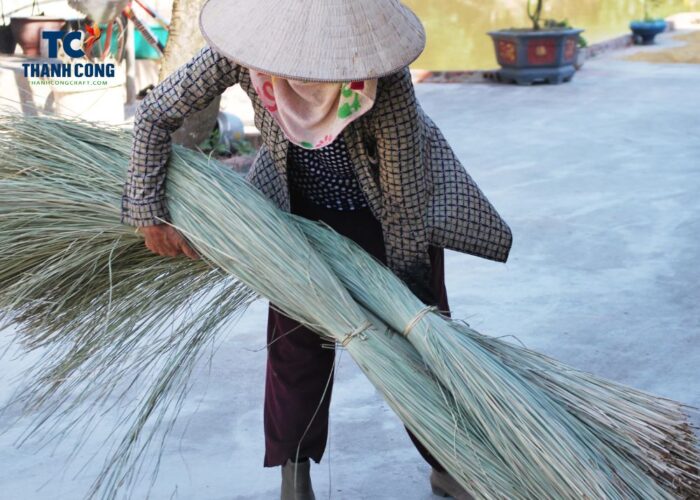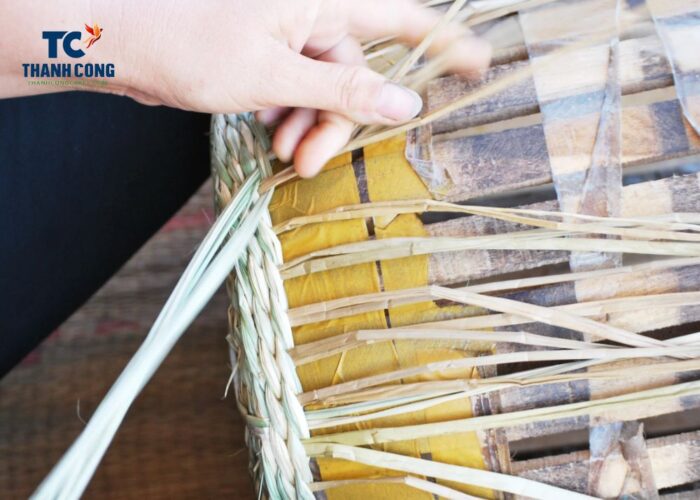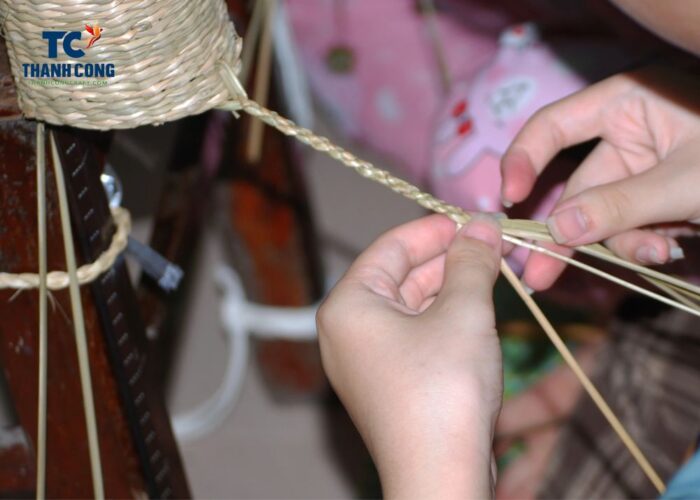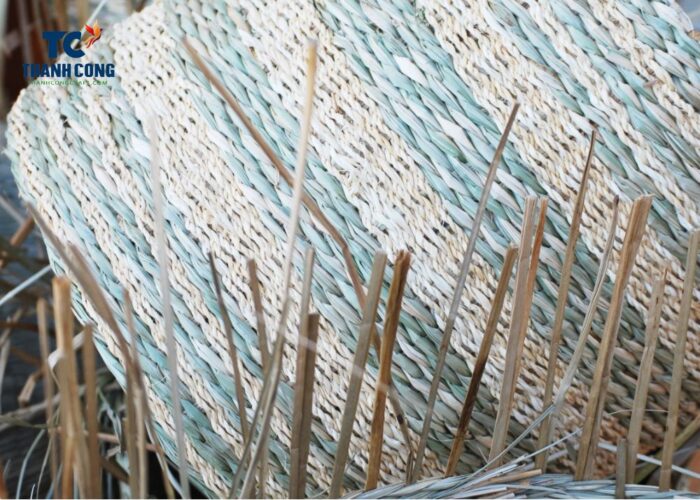Seagrass, with its natural flexibility and earthy charm, becomes the perfect material for weaving a basket that is not only functional but also a unique piece of art.
In this seagrass basket weaving materials, unraveling how to make a seagrass basket transform raw materials into a functional and aesthetically pleasing piece. Let’s see how are seagrass baskets made!
1. Seagrass Basket Weaving Materials
Key components include seagrass, a versatile and flexible material known for its slender stems and growth in coastal areas. The slender yet robust nature of seagrass makes it an ideal weaving material, offering both strength and flexibility.

Additionally, weavers often utilize a variety of tools such as scissors, rulers, and mesh frames to shape and structure the baskets. When weaving, the ends of seagrass strands are buttressed together, creating a seamless and cohesive design. The use of filler materials like reed can complement seagrass, adding texture and variety to the finished product.
Understanding the intricacies of seagrass basket weaving materials is crucial for creating durable and visually appealing baskets. The combination of natural elements and craftsmanship results in handmade pieces that not only serve practical purposes but also showcase the beauty of sustainable and eco-friendly materials.
Where to Buy Seagrass for Weaving?
To buy seagrass for weaving, you can check out online retailers on Amazon, Etsy, and eBay that offer a wide variety of options.
While Craft and hobby stores and eco-friendly stores may sell seagrass for crafts.
Additionally, exploring craft markets or considering online wholesale suppliers to buy in bulk are viable options.
2. How to Make A Seagrass Basket?
Weaving a simple seagrass basket involves a series of steps that blend creativity with craftsmanship. Here’s how to make a seagrass basket step by step.
2.1 Gather Your Materials
Start by collecting the necessary materials. You’ll need seagrass, scissors, a ruler, a non-slip rug pad (optional), and a flat surface to work on.
Do you soak seagrass before weaving? Seagrass, unlike some other natural materials used in weaving, do not require soaking, as it is already quite flexible. Soaking can potentially harm the material and make it less suitable for weaving.
2.2 Measure And Cut
Using a ruler, carefully measure and cut the seagrass to your desired length, ensuring uniformity for a polished finish. The attention to detail in this step not only establishes the structural integrity of the basket but also plays a key role in determining its overall aesthetic.
Visualize the end result as you meticulously measure and cut, laying the foundation for a well-crafted and visually appealing seagrass basket.
2.3 Prepare The Base
If you desire a thicker seagrass basket, incorporate a non-slip rug pad as the base. This not only enhances the overall density and tactile feel of the basket but also ensures stability to prevent slipping.
In this step, for those aiming for a more substantial seagrass basket, include a non-slip rug pad as the foundational layer.

2.4 Begin Weaving
Enter the weaving basket phase by laying seagrass horizontally, slightly overlapping each strand. As you begin weaving, introduce vertical strands through the horizontal ones, alternating over and under.
Pay attention to tension and spacing, envisioning the unique texture and pattern that will characterize your seagrass basket.

2.5 Secure The Ends
Once you’ve achieved the desired size, secure the ends by either elegantly tucking them under the weaving or tying knots, adding a distinctive touch to your creation.
Trim any excess seagrass for a neat and polished appearance, ensuring not just visual appeal but also practical functionality.
2.6 Finishing Touches
Check for and secure any loose strands, ensuring both aesthetics and durability.You can also add a border by weaving a contrasting color or thicker seagrass around the edges.
These finishing touches not only contribute to the overall charm but also eye-catching addition to your space.

2.7 Let It Set
In the final stretch of your wicker basket crafting, let your creation set and dry – a pivotal step for ensuring the lasting stability of your hand woven masterpiece. This phase allows the intricately woven patterns to solidify, contributing to the overall resilience of the basket.
2.8 Enjoy Your Creation
After the complete drying of your seagrass basket, place it in your chosen spot and relish the natural, handmade beauty it brings to your home.
Whether used for decoration or practical storage, this handcrafted piece seamlessly integrates into your living space, adding character and warmth.
Check out more here: https://thanhcongcraft.com/how-to-weave-a-seagrass-basket-step-by-step/
3. FAQs
3.1 What Grasses Are Used for Basket Weaving? What Is The Best Grass for Weaving?
Basket or seagrass belly basket weaving encompasses a rich selection of grasses, each chosen for its unique qualities in contributing to the artistry of the craft.
Seagrass, celebrated for its flexibility and strength, is a preferred choice, especially for coiled baskets, delivering a smooth and uniform finish.
Sweetgrass, known for its fine texture and pleasant fragrance, holds cultural significance in Native American basketry.
Cattail, rush, and willow offer different textures and strengths, catering to various weaving techniques. Pine needles, though not true grasses, find their place in basketry for their flexibility, often used in coiled designs.
The selection of the best grass for weaving depends on the specific characteristics desired, allowing weavers to infuse their creations with a blend of functionality and aesthetic appeal.
3.2 Can Seagrass Baskets Get Wet?
Yes, seagrass baskets can get wet, if a seagrass basket does get wet, it’s advisable to allow it to air dry thoroughly.
Placing it in a well-ventilated area away from direct sunlight can help prevent damage. Avoid exposing the basket to heat sources, as excessive heat can cause the fibers to become brittle.
It’s worth noting that while seagrass baskets can tolerate some moisture, they are not designed for prolonged exposure to water.
If you plan to use a seagrass basket in a bathroom or other areas prone to high humidity, consider taking measures to protect it, such as using a liner or applying a protective sealant if appropriate for the basket’s design.
3.3 How Do You Preserve Seagrass Baskets?
Preserving seagrass baskets involves avoiding prolonged moisture exposure, regular dusting, and occasional cleaning. Protecting them from direct sunlight and applying a compatible sealant, if suitable, adds an extra layer of defense.
Using liners for damp items and storing baskets in dry areas are crucial, while periodic rearrangement ensures even wear distribution.
When handling, lift from the bottom to prevent stress on the fibers. These practices collectively maintain the longevity and aesthetic charm of seagrass baskets in your living space.
In conclusion, mastering the art of how to make a seagrass basket not only offers a creative outlet but also introduces you to the intricacies of weaving nature’s fibers into functional and aesthetically pleasing forms. By embracing the techniques and tips shared in this guide, you embark on a path of transforming seagrass strands into a unique and personal masterpiece.
If you have any further questions, don’t hesitate to send thanhcongcraft an email us at info@thanhcongcraft.com or message us at WhatsApp: +84967485411. Hope to serve you soon! Best regard!












